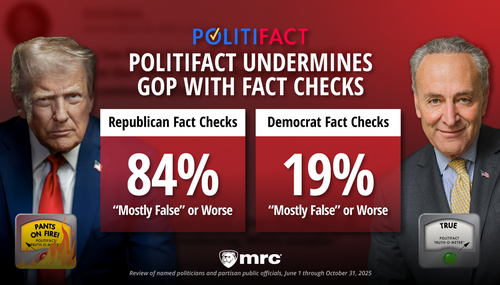 Eli Tan, a young San Francisco-based tech reporter for the New York Times, devoted 2,500 words in the paper’s Sunday edition decrying the spread of right-wing conspiracy theories, now that no one subscribes to the Times or local newspapers anymore: “How Misinformation and Partisan ‘New Media’ Changed a California Town.” The story was heavily based on a "militia" incidence that occurred five years ago.
Eli Tan, a young San Francisco-based tech reporter for the New York Times, devoted 2,500 words in the paper’s Sunday edition decrying the spread of right-wing conspiracy theories, now that no one subscribes to the Times or local newspapers anymore: “How Misinformation and Partisan ‘New Media’ Changed a California Town.” The story was heavily based on a "militia" incidence that occurred five years ago.
Tan opened this photo-heavy feature by harking back to the good old days of newspapers and only a few news broadcasts to choose from.
Nightly news broadcasts played on living room televisions. Copies of local newspapers lined doorsteps on Sunday mornings. The town even had two media outlets dedicated to rodeo and horse roping news.
But that version of Oakdale is a thing of the past.
First the nearby newspapers shrank, and hundreds of local reporters in the region became handfuls. Then came the presidential elections of 2016 and 2020, and the pandemic; suddenly cable networks long deemed trustworthy were peddlers of fake news, on the right and the left.
By the 2024 election, when its county, Stanislaus, was among the 10 in California that President Trump flipped red, it wasn’t just trust in traditional media that had vanished from Oakdale -- it was the media itself.
Information "professionals" are absolutely necessary. Or so they say. Who's letting amateurs cook the news?
Now, in place of longtime TV pundits and radio hosts, residents turn to a new sphere of podcasters and online influencers to get their political news. Facebook groups for local events run by residents have replaced the role of local newspapers, elevating the county’s “keyboard warriors” to roles akin to editors in chief.
Of the 80 Oakdale residents The New York Times spoke to for this article, not a single one subscribed to a regional news site, The New York Times, The Wall Street Journal or The Washington Post....
But seeking truth in a post-journalism world of Facebook groups and online influencers has left some Oakdale residents feeling less informed than before. And efforts to manage misinformation that culminated in an armed militia storming the town in 2020 have changed the very nature of the community.
Tan only saw harmful coverage on Facebook, not in the censorious behavior of the left, bolstered by a compliant mainstream press, in the summer of 2020, when Black Lives Matters protests became violent rampages and the media's stern Covid lectures were cheerfully tossed aside.
As local news outlets shrank throughout the Central Valley in the 2010s, Facebook groups dedicated to local events started popping up in their place. And for years, they were harmless. But that changed in 2020.
With residents stuck at home during the pandemic, the groups thrived. But as new members joined by the thousands, conspiracy theories and political debates overtook posts about school board meetings and local elections.
Tan went back to a damp squib of a supposed threat that happened five years ago to defend the seething liberal press of today.
Then, the militia incident happened.
Julie Logan, an in-home health care worker in Oakdale, can still remember the scene: It was a weekend morning in June, and the downtown farmers’ market had been replaced by a scene resembling a military operation.
Gunmen patrolled the sidewalks dressed head to toe in brown camouflage; store windows were boarded up; some of the men perched from the rooftops in tactical gear, brandishing rifles.
The militia was prepared to defend against an imminent threat: Black Lives Matter protesters, they believed, were plotting to invade the town and would be arriving on buses from the Bay Area at any moment.
They waited and waited. But the protesters never came.
Left unsaid was that BLM protests indeed often descended into vandalism and violence, though the Times itself did it best to downplay, euphemize, or simply avoid those truths in 2020.
There’s a lesson here about the blowback from social media censorship that ends up empowering so-called misinformation, but one doubts The Times, which spent years cheering on leftist censorship, is ready for it.
But the new focus on moderation had an unintended effect: Frustrated residents whose comments were removed began to create their own groups in protest....
The Times took its latest strange shot at an anti-Chinese Communist Party newspaper, The Epoch Times, "known to include right-wing misinformation with an anti-China slant," before comparing and contrasting the news diet of a husband and wife.
The Ortegas’ news habits couldn’t be more different. Ms. Ortega keeps up with current events exclusively through La Mesa Caliente, a Spanish-language talk show on Telemundo hosted by four women. Mr. Ortega gets his news from an orbit of right-wing male YouTube personalities like Ben Shapiro, Charlie Kirk and Dan Bongino....
La Mesa Caliente is a safely liberal, if less crazed, Latina version of The View, but did not receive an ideological label.
Tan dipped only briefly into a concrete reason why people no longer trust the mainstream press --- the cover up of President Biden’s mental decline.
Watching President Biden struggle to string together complete sentences, he couldn’t help but think that the press corps in Washington that was supposed to keep the country informed -- including Oakdale -- had let him down.
“It felt like a failure,” Mr. Freeman said. “How could the media not tell us what we were seeing?”
Meanwhile, MSNBC came off as left-leaning but basically reliable, unlike those who “embrace conspiracy theories” and "right-wing misinformation" (As if MSNBC has never embraced conspiracy theories.) (Click "Expand.)
Liberal residents in Oakdale say their news diets haven’t changed as much as their conservative counterparts. Harvey Melgoza, 67, still listens to MSNBC on the radio while working at his shoe repair store downtown, like he has for as long as he can remember. And he will sometimes read The Oakdale Leader on the occasion that his neighbor, Doug, drops off extra copies at his doorstep.
Since the start of the pandemic, he has watched some of his neighbors embrace conspiracy theories, or grow suddenly fearful of Mexican immigrants coming across the border.
MSNBC “might sometimes have a bias,” he said, “but at least it gives me a good sense of what’s happening in the world.”




